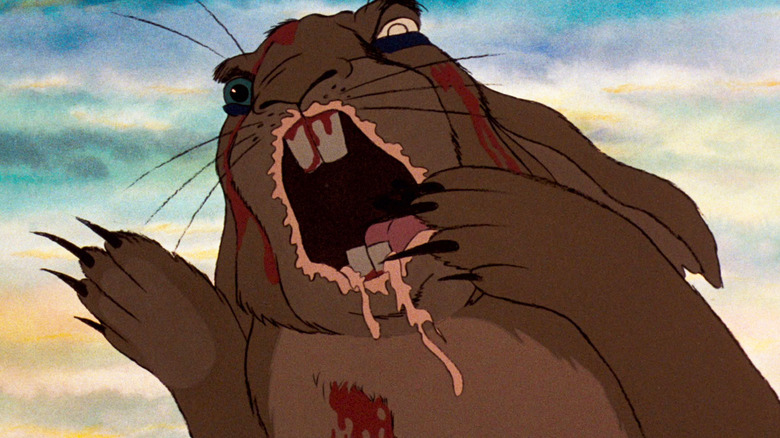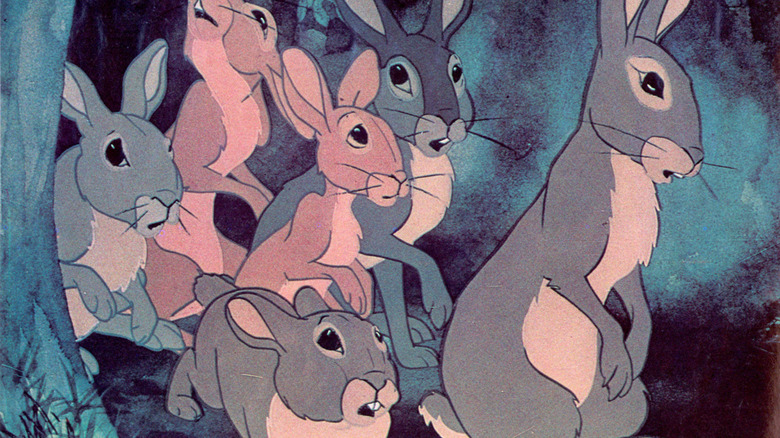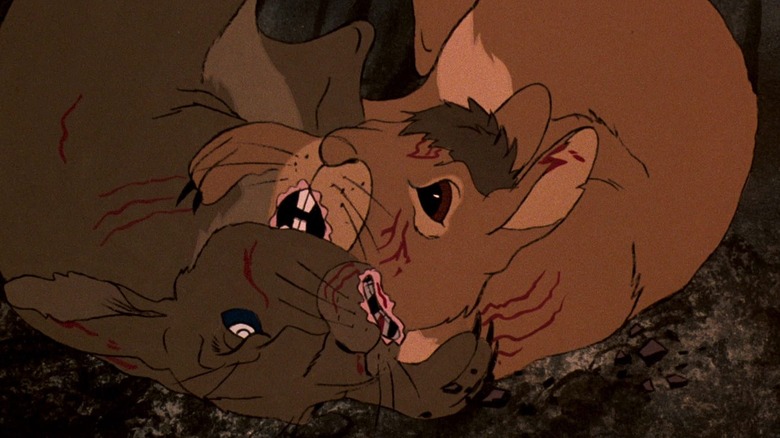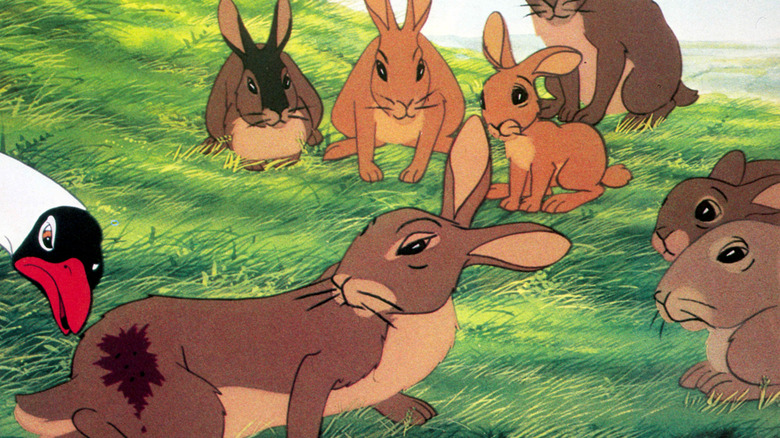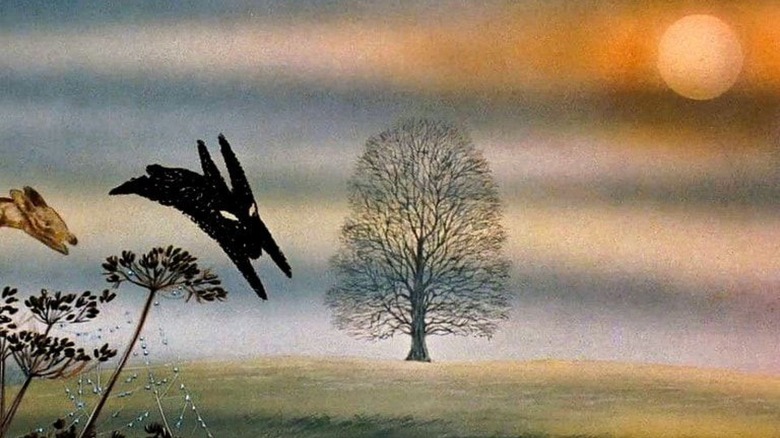The UK Ratings Blunder That Traumatized A Generation
The early days of video rental in the United Kingdom was like the wild west of home entertainment. For people in the UK, at least. Long before Blockbuster arrived and edged out local outlets, you were just as likely to find a few shelves of VHS tapes behind a curtain at a petrol station or tucked away beside the meat counter in a grocery store. Without legislation covering video releases, it was a boom time for grotty low-budget horror movies, and the shelves were gory with lurid and sometimes very graphic cover art. I couldn't get enough of looking at those boxes, although I was too chicken to rent out anything much scarier than "Fright Night."
Eventually, the press and moral crusaders like Mary Whitehouse kicked up a stink and spoiled our fun, causing a massive backlash against the so-called "video nasties." The Director of Public Prosecutions (DPP) drew up their first list of offending movies in 1983, and in 1984 the Video Recordings Act was passed, with the British Board of Film Classification (BBFC) now responsible for both cinematic and home video releases. So it was goodbye to "Driller Killer" and "Zombie Flesh Eaters." See you on bootleg, "Cannibal Holocaust." Subsequent lists were published with varying severity of punishment for anyone distributing the titles, with legitimate classics like "The Evil Dead," "Tenebrae" and "Possession" caught up in the mix (via BFI).
It was all to protect the kids and teenagers, you see, to shield us from the corrupting influence of industrial-strength splatter, Naziploitation, and sordid rape revenge flicks. In many cases, they were probably right. There was some truly ghoulish trash out there, and only the most dedicated gorehound would miss half the sleazy, badly-made, sadistic junk on the lists. That wasn't the point though, was it?
Especially since one movie out there was responsible for more nightmares than all of the video nasties put together. It didn't have "Zombie," "Cannibal," or "SS" in the title, and it carried the "U" certificate for Universal, meaning suitable for all. To the unwary, it looked like a nice cartoon about lovely fluffy bunny rabbits. That film was "Watership Down."
So what happens in Watership Down?
Martin Rosen's "Watership Down" opens with a brilliantly animated piece of rabbit mythology explaining how the whole world became the lapine enemy. It really draws us into the world of the rabbit characters from the outset and gives us a little heads-up about some of the horrors to follow. Then we're off through the sedate English countryside while the gentle theme tune plays, across hills, fields, woods, and streams, the beautiful natural scene punctuated by the occasional sign of humans — a churchyard, a row of pylons, a road flanked by hedgerows.
We arrive outside Sandleford warren, where the rabbits are enjoying a little supper after two workmen have knocked off for the evening. We meet pragmatic Hazel (John Hurt) and his timid brother Fiver (Richard Briers), who will be our guides on this adventure. It's excellent casting, and the warm vocal performances from Hurt and Briers are instantly welcoming. Apart from those two, "Watership Down" has an embarrassment of vocal talent, including Ralph Richardson, Denholm Elliot, Nigel Hawthorne, Michael Hordern, and Zero Mostel in his last film performance.
Fiver is psychic, and he has a terrifying vision of the fields running with blood, a harbinger of the warren's imminent fate. The pair try to convince the Chief Rabbit (Richardson) that a "bad danger" is coming, but he doesn't believe them. With Fiver still spooked they decided to leave at night, accompanied by several other rabbits including Bigwig (Michael Graham Cox), formerly an enforcer of the Owsla, or the rabbit police. Together, they embark on a perilous adventure across the countryside to find a safer new warren.
It's a classic hero's journey on a small scale as the rabbits encounter many dangers along the way. Hawks, cats, dogs and snares are all bad enough, but those are nothing compared to the murderous threat of the sinister Efrafrans, a gang of thuggish rabbits headed by the ferocious, dead-eyed despot General Woundwort. Typing his name just gave me an involuntary shudder of fear.
Why is Watership Down so traumatic?
The origin of Richard Adams' source novel has a semi-mythic ring to it; like Lewis Carroll's trip down the rabbit hole, it began as stories spun to amuse two young girls. They were his daughters, demanding entertainment on car journeys. When Adams decided to set those stories on paper, he researched rabbit life meticulously. He based his rabbit society on "The Private Life of the Rabbit" by prolific writer and naturalist Ronald Lockley (via Country File) with whom he later took a trip across the Antarctic. As a result, the story had none of the cutesiness of Disney films, describing the rabbits and their environment in patient, detailed way; this might be a story involving a psychic rabbit, but it certainly doesn't shy away from the cruelties of nature and the harsh dangers faced by his lapine protagonists. Adams also developed an extensive society, mythology, and even a language for his rabbits, like a mini Middle Earth for cottontails.
That seriousness of approach and lack of sentimentality translated into Martin Rosen's film adaptation. Although it was an animated feature with idyllic music and soft water color backdrops, it didn't hold back on the graphic violence and trippy nightmare sequences. Rabbits fight, claw each other, rip out chunks of fur, and brawl each other to a bloody standstill. One rabbit is snatched by a bird of prey while others are savaged by a dog. Bigwig gets caught in a snare and almost dies, while Hazel is shot and narrowly avoids a walk with the Black Rabbit of Inlé; even "Bright Eyes," the Art Garfunkel song from this sequence which sounds so mawkish in its pop single arrangement, is mysterious and haunting in its original context.
Then you've got the monstrous presence of General Woundwort and his henchmen waging war on our heroes, resulting in much bloody carnage. So much blood. And that's all before you take into account Fiver's disturbing visions and a psychedelic scene depicting the suffocating fate of the Sandleford rabbits who stayed behind. No wonder it was nightmare fuel for so many youngsters, lulled into a false sense of security by that innocuous "U" certificate.
The aftermath of the Watership Down ratings blunder
The origina examiner's report for "Watership Down" (available to download on the BBFC website) concludes:
"Animation removes the realistic gory horror in the occasional scenes of violence and bloodshed, and we felt that, while the film may move children emotionally during the film's duration, it could not seriously trouble them once the spell of the story is broken, and that a U certificate was therefore quite appropriate."
Try telling that to thousands of kids up and down the land who were exposed to the bunny mayhem, like Phil Hoad in his piece entitled "Watership Down: the film that frightened me the most," who describes (via The Guardian):
"Blood blotting a vast field, threatening to engulf them all. Skeletal tree outlines crack like veins through the insanguinated sods. Their branches twist and undulate with queasy malice. The horror, the horror! I was a kindergarten Kurtz; the toddler who had seen too much. It was like reality was melting. I have dim memories of fleeing from a dark cavern of a Newcastle cinema, desperate for bright air and parental comfort."
Despite what the examiner said, how many other family films feature "occasional scenes of violence and bloodshed," especially involving animals that most people in the UK regard as harmless pets? If it held a PG (Parental Guidance) certificate, parents may have approached the film with more caution before exposing their offspring to it. As it was, many probably thought it was just a nice cartoon to keep the kids quiet for a couple of hours.
I still remember watching aghast as a child. It was just about at my upper threshold for terror; one more rabbit bleeding out or another shot of General Woundwort launching himself into battle with teeth gnashing might have done it for me. But "Watership Down" was a film I went back to again and again, because once you're over the shock, it is what it is: a really terrific adventure story.
Watership Down scaring new generations of kids
The BBFC site states that "Watership Down" was most recently rated as a "U" in 2013, and you get the sense that they were determined to stick to their guns on this one (via BBFC):
"While the film has a happy ending and contains many positive messages for young audiences about bravery, friendship and the environment, younger or more sensitive viewers have found some scenes upsetting or worrying and over the years the BBFC has received numerous complaints about the suitability of Watership Down at U."
Notice that rather sniffy little "more sensitive viewers" in there? I reckon they knew they had screwed up and got very tired of being reminded about it for the next 40 years. David Austin, the current BBFC Chief Executive appointed in 2015, was forced to address the issue again the following year when UK's Channel 5 upset some viewers by screening the film on Easter Sunday afternoon. He admitted that if it was released today it would probably get a PG certificate (via The Mirror). Undeterred, the channel repeated the stunt the following year, provoking further outrage among parents who had somehow managed to avoid the child-scarring reputation of "Watership Down" for their whole lives (via Metro).
No doubt many seasoned "Watership Down" survivors were ready for old mental wounds to be re-opened when the BBC's CGI-animated remake dropped a few days before Christmas in 2018. Yet the general consensus was that the violence and horror from the original had been toned down, although IndieWire felt that one scene was "as emotionally horrifying as the massacre kicking off 'Saving Private Ryan.'" I can't judge that comment because I've yet to see it, partly put off by the ugly CG that makes it look like a feature-length PlayStation cutscene, with little of the original's pastoral beauty. Plus, when I actually considered watching it on Netflix with the kids, my other half intervened in no uncertain terms; "You're not bloody letting them watch that!"
She saw the original as a little kid, too.
